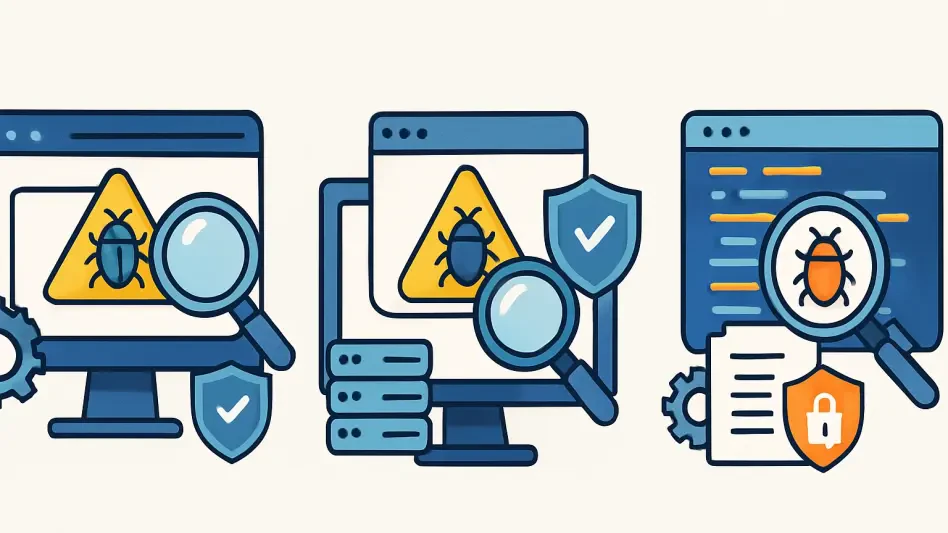In today’s rapidly shifting cybersecurity landscape, where digital threats loom larger than ever, Dynamic Application Security Testing (DAST) platforms have emerged as vital tools for safeguarding web applications against runtime vulnerabilities. As organizations across industries accelerate their digital transformation journeys and adopt cloud-native architectures, the demand for robust, automated solutions to secure applications, APIs, and microservices has reached unprecedented levels. This article delves into the leading DAST platforms of the current year, offering a detailed exploration of their strengths, unique features, and overall impact on application security. With cyber risks growing more complex and frequent, choosing the right DAST tool is no longer just a technical decision—it’s a strategic imperative for enterprises aiming to protect their digital assets and maintain trust in an interconnected world.
The evaluation of top DAST solutions for 2025 focuses on critical metrics such as accuracy in detecting vulnerabilities, scalability to handle enterprise-level demands, seamless integration with modern workflows, and the overall value delivered to security and development teams. From Chief Information Security Officers (CISOs) to application security (AppSec) specialists and developers, stakeholders at every level are seeking platforms that not only identify exploitable flaws but also enable swift, effective remediation. This analysis aims to guide decision-makers through the crowded field of DAST tools, spotlighting the frontrunners that are shaping the future of cybersecurity. By understanding the nuances of these platforms, organizations can better fortify their defenses against evolving threats.
Emerging Trends in DAST Technology
The realm of DAST platforms in 2025 is marked by a significant shift toward automation and alignment with modern software development practices. As organizations strive to keep pace with accelerated release cycles, leading tools are embedding continuous testing capabilities directly into CI/CD pipelines. This “shift-left” philosophy ensures that security checks occur early in the development process, catching vulnerabilities long before they reach production environments. Such an approach not only minimizes risks but also streamlines workflows, reducing friction between security and development teams. The emphasis on automation reflects a broader industry recognition that manual testing alone cannot match the speed and scale of today’s software delivery models.
Another pivotal trend shaping the DAST landscape is the focus on precision in vulnerability detection. Security teams are increasingly burdened by the challenge of sifting through alerts, many of which turn out to be false positives. Top platforms are addressing this by incorporating advanced validation mechanisms that confirm the exploitability of identified issues, ensuring that remediation efforts are directed toward genuine threats. This push for accuracy is transforming how organizations allocate their resources, allowing them to prioritize critical risks without wasting time on irrelevant noise. As a result, tools that excel in delivering reliable, actionable insights are gaining prominence among enterprises seeking efficiency in their security operations.
A third notable development is the adaptation of DAST platforms to cloud-native and hybrid infrastructures, mirroring the ongoing evolution of IT environments. With many organizations operating across distributed systems, the ability to deploy testing tools flexibly—whether as cloud-based solutions or on-premises setups—has become essential. This versatility supports the needs of diverse teams and architectures, ensuring that security measures keep up with dynamic, scalable systems. Platforms offering such adaptability are particularly valued by enterprises managing complex, multi-cloud portfolios, as they provide consistent protection without the constraints of a one-size-fits-all model.
Defining Features of Elite DAST Solutions
When evaluating the leading DAST platforms, certain capabilities consistently set the best apart from the rest. Integration with DevSecOps frameworks stands out as a critical feature, enabling seamless collaboration between security specialists and developers. Tools that provide real-time feedback directly within development environments help bridge the gap between these often siloed teams, fostering a shared commitment to security. Beyond mere integration, the most effective platforms offer detailed remediation guidance, empowering developers to address vulnerabilities without requiring deep security expertise. This focus on usability is reshaping how organizations embed security into their day-to-day processes, making it a core component of software creation.
Equally important is the breadth of coverage that top DAST tools provide across various application components. Modern architectures rely heavily on APIs and microservices alongside traditional web applications, creating an expanded attack surface that demands comprehensive testing. Platforms that can thoroughly scan these diverse elements ensure that no potential entry point for attackers is overlooked. This capability is particularly crucial as applications become more interconnected, with vulnerabilities in one layer often cascading to others. Solutions that prioritize such wide-ranging protection are indispensable for organizations aiming to secure their entire digital ecosystem against sophisticated threats.
For industries bound by strict regulatory requirements, compliance support emerges as a defining characteristic of elite DAST platforms. Tools that offer robust reporting features and alignment with standards like GDPR, HIPAA, or PCI DSS are invaluable for sectors such as finance, healthcare, and government. These platforms not only help organizations avoid costly penalties but also build trust with stakeholders by demonstrating adherence to legal and ethical benchmarks. The ability to generate customizable reports tailored to different audiences—whether auditors, executives, or technical teams—further enhances their appeal, ensuring that compliance needs are met without sacrificing operational efficiency.
Highlighting the Leaders in DAST Innovation
Among the array of DAST platforms evaluated for 2025, several stand out for their specialized strengths tailored to distinct organizational needs. Enterprise-grade solutions are leading the pack with their unparalleled scalability and precision, designed to manage vast application portfolios with thousands of simultaneous scans. These tools often incorporate advanced algorithms to validate vulnerabilities, drastically reducing false positives and ensuring that security teams focus on real risks. Their robust architecture makes them ideal for large organizations with complex environments, where high-stakes security demands reliable, high-assurance results. Such platforms are often the go-to choice for global enterprises seeking to protect critical digital assets under intense scrutiny.
In contrast, developer-focused DAST tools are gaining ground by emphasizing ease of use and direct integration into CI/CD workflows. These platforms are built with engineering teams in mind, offering rapid feedback loops that allow developers to address issues without disrupting their pace. By simplifying the remediation process through clear, actionable insights, they encourage a collaborative approach to security that doesn’t hinder innovation. Their lightweight design and automation features cater especially to agile teams and cloud-native organizations, where speed and adaptability are paramount. This developer-first philosophy is proving essential in environments where security must align with rapid deployment cycles.
For sectors under heavy regulatory oversight, certain DAST solutions distinguish themselves with comprehensive compliance features and a unified approach to security testing. These platforms often combine DAST with complementary methodologies like Static Application Security Testing (SAST), providing a holistic view of risks across the software development lifecycle. Their ability to generate detailed compliance reports ensures that organizations remain audit-ready, addressing stringent requirements with ease. This makes them particularly suited to industries like banking or healthcare, where meeting regulatory standards is as critical as mitigating vulnerabilities, offering a dual focus that balances security and accountability.
Navigating the Right Fit for Organizational Needs
The diversity of DAST platforms available in 2025 underscores a fundamental truth: no single solution suits every scenario. Large enterprises with sprawling digital footprints often gravitate toward tools that prioritize depth, scalability, and integration with broader security ecosystems. These organizations require platforms capable of handling intricate setups while delivering precise results, often at a premium cost that reflects their advanced capabilities. The focus for such entities is on long-term risk reduction and operational resilience, ensuring that their extensive application environments remain secure even under the most demanding conditions. Matching these robust tools to specific enterprise challenges is key to maximizing their protective impact.
On the other hand, smaller organizations or startups may find greater value in accessible, cost-effective DAST solutions that don’t skimp on essential security features. These tools, including community-driven or open-source options, provide a practical entry point for teams with limited budgets or less complex needs. Supported by active networks of security enthusiasts, they often stay current with emerging threats through frequent updates, offering a level of protection that belies their lower cost. Their flexibility also allows for customization, making them a viable choice for growing businesses that need scalable yet affordable security as they expand their digital presence over time.
The decision-making process is further nuanced by considerations of deployment models and workflow preferences. Organizations must weigh the ease of cloud-based solutions against the control offered by on-premises setups, especially when data residency or compliance constraints come into play. Similarly, the balance between fully automated scanning and manual customization options can influence a platform’s suitability for a given team’s structure and expertise. Ultimately, aligning a DAST tool’s features with an organization’s unique challenges—whether reducing alert fatigue, scaling for multi-cloud environments, or enabling developer autonomy—serves as the roadmap for enhancing application security in a tailored, effective manner.
Charting the Path Forward in Application Security
Reflecting on the DAST landscape of 2025, it’s evident that the evolution of these platforms has reached a pivotal moment, driven by the urgent need to counter increasingly sophisticated cyber threats. The rankings reveal a dynamic field of tools that have adapted to meet diverse demands, from enterprise scalability to developer empowerment, ensuring that organizations of all sizes have access to critical security capabilities. Each leading solution has carved out its niche, whether through precision in vulnerability detection, seamless DevSecOps integration, or robust compliance support, providing a spectrum of options for tackling runtime risks.
Looking ahead, the path to stronger application security lies in leveraging these insights to make strategic investments in DAST tools that align with specific operational goals and risk profiles. Decision-makers should consider conducting thorough assessments of their current security posture and future growth plans to pinpoint the most fitting platform. Exploring pilot programs or leveraging community resources for open-source options can also offer practical starting points. As cyber threats continue to evolve, staying proactive with regular updates and fostering collaboration between security and development teams will be essential steps in maintaining a resilient defense against vulnerabilities in the digital realm.








